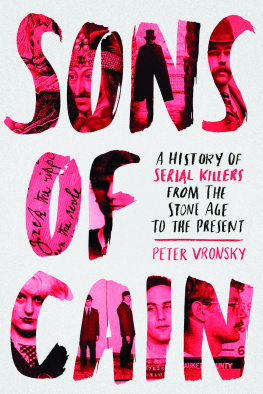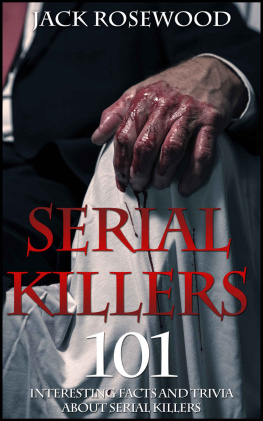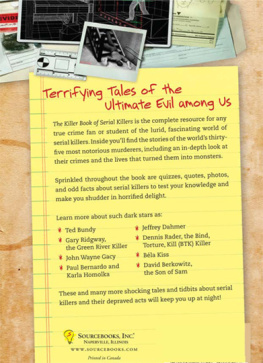THIS IS A CARLTON BOOK
Original interviews and research material
copyright Brook Lapping 2001
All other text copyright Carlton Books
Limited 2001
This paperback edition published in 2003
by Carlton Books Limited
20 Mortimer Street
London W1T 3JW
First published in 2001
This book is sold subject to the condition that it shall not, by way of trade or otherwise, be lent, resold, hired out or otherwise circulated without the publisher's prior written consent in any form of cover or binding other than that in which it is published and without a similar condition including this condition, being imposed upon the subsequent purchaser.
All rights reserved.
A CIP catalogue record for this book is available from the British Library.
ISBN 978-1-78011-050-9
Printed and bound in Great Britain

CONTENTS
A CKNOWLEDGEMENTS
G RATEFUL THANKS , first, to Brook Lapping Productions for permission to use research material from their series To Kill and Kill Again, and for reading my text to check against further material received by them and not known to me. And to Penny Simpson of Carlton Books and Carole Peters, Tina Darcy, Alex Raw and Sophie Milland of Brook Lapping for fielding my questions about it and, where possible, meeting my requests for more. Spelling of names normally follows that of the Brook Lapping researchers, as does dating of incidents where they established precise dates. Direct quotations from the following people are all taken from Brook Lapping interview material which may or may not have been broadcast: Kelvin Ashby, Suzanne Bennison, Clive Bouch, David Briffett, Martin Burlin, James Chadwin, Dave Cox, James Droney, Evelyn Dymond, Julie Evans, Ian Fairley, Ray Fisch, Chris Frayling, Mike Green, Fred Harrison, Roy Hazelwood, Rupert Heritage, Jane Hibbert, Pauline Hildreth, Dick Holland, Bill Hunt, Peter Jay, Winnie Johnstone, Danny Kilbride, Geoff Knupfer, Michael Massheder, Brian Masters, Caroline Owens, John Pollard, Bernard Postles, Robert Ressler, John Rutherford, Elizabeth Scott, Ron Shaw, Harry Smelt, Bob Spiers, Ron Stocks, Alan West, Megan Winterburn, David Zackrisson.
Thanks to Mark Olshaker and John Douglas (and Messrs Scribner) for permission to quote from Mindhunter, The Anatomy of Motive and The Cases That Haunt Us. Thanks to Mike Berry for information about psychological profiling and profilers, and the Rosemary West trial. To Tom Witter and the team at Flame TV for access to detailed research on one serial killer, and to John Connor for insider views on police work. To Stewart Evans for confirmation of one piece of his unpublished research. To Paul Begg, Keith Skinner and all contributors to Ripperologist, Ripperana and Spryders Internet Jack the Ripper message boards for keeping me au fait with enthusiasts views on multiple murder and ongoing problems. To Richard Dawes for indefatigable copy-editing. To Paul Savory, without whose laptop in America and hospitality in London I should not have been able to complete this commission. To my agent, Richard Jeffs, who saw that I was free to write without administrative distractions. And to Karen, who has borne with my prolonged disappearance to the bookshelves and the keyboard at a difficult time.
I NTRODUCTION
I S THERE ANYTHING NEW to say about Jack the Ripper, Haigh, Christie, the Moors Murderers, Dennis Nilsen or Fred West? Havent these gruesome serial murderers been fully exposed in book after book?
Well, not quite as fully as you might think, was the discovery that television researchers made when they looked into the possibility of a television series on serial killers. There is ongoing newly published research on the historical cases that may not be familiar. There are witnesses and investigators whose stories have never been told. And there is the FBIs Behavioral Science Unit, throwing new light on every old case it examines and puts into context. And when the psychological context and the historical context are combined, the history of British serial murder offers a fascinating insight into the ways in which criminal detection has advanced, and the ways in which relations between police and press have often determined public attitudes.
The first notorious British serial murderer was Sawney Bean, the Scottish cannibal who preyed on travellers along the coast of Galloway. He probably never existed, as no record of him is found anywhere until the seventeenth century, about three hundred years after his supposed execution. Likewise Sweeney Todd, the Demon Barber of Fleet Street was the completely fictitious creation of a Victorian blood-and-thunder writer, despite a recent undocumented books pretence that he really existed. The first genuine killers to attract serious notice in Britain by the sheer incremental number of their crimes were Burke and Hare in 1828. Their motive for killing 16 people was purely commercial. They wanted bodies to sell to an anatomist. Their English imitators Bishop and Head (executed under the names Bishop and Williams) confessed to five killings, and thought that many other London bodysnatchers had attempted burking. But they attracted far less public attention than the Edinburgh ghouls, whose crimes prompted one of the first experiments in forensic (which literally means court-related, not scientific) pathology as anatomists at Edinburgh University experimented on rabbits to establish the difference between bruising inflicted before and after death.
There were other nineteenth-century murderers who claimed more than 10 victims. Dr Palmer of Rugeley killed numerous creditors and relatives whose lives he had insured. Mary Ann Cotton disposed of unwanted husbands and children. These people attracted notice, but nobody thought of them as inherently different from any other kind of murderer. Like Burke or the mythical Bean and Todd, they acted from obviously rational and self-interested motives. It was the mysterious and undetected Jack the Ripper who first seemed to represent something strange and inexplicable.
Despite the even odder murders of Dr Cream, it was not until 1948, when John George Haigh claimed to have killed nine people in order to drink their blood, that attention again focused on the mystery of mass murderers psychological motivation. Serious academic investigation of the problem appeared in 1979 when Dr R.P. Brittain published an article on The Sadistic Murderer and this was followed by Canadian anthropologist Elliott Leytons suggestion that multiple murders perpetrated with no financial motive were an attempt by disadvantaged losers in rigidly stratified competitive industrial societies to take a bitter revenge on classes that excluded or threatened them. This explanation meshed, to some extent, with Colin Wilsons historically based suggestion that sexual serial killing (Lustmrder as the Germans had started to call it) had replaced murder for gain since industrialization had secured adequate food and shelter for the majority of people, and according to Maslovian psychology, the self-realizing need for physical comfort and security was now replaced by a need to establish an esteemed identity or some higher mental and spiritual gratification. Certain people whose inner belief in their own superiority was actually frustrated by personal inadequacy would then find horrible gratification in imposing themselves murderously on sexually desirable victims.
A very different and more mechanical approach to the supposed epidemic of serial murder in the late twentieth century was proposed by neuroscientist Joel Norris. In addition to certain psychological disorders, he suggested that a predisposition to serial killing might be caused by damage to the limbic area of the brain. This could be innate, or might be caused by head injury or the ingestion of excessive lead and cadmium which could occur in poor diet. Parallel genetic research was concurrently suggesting that the presence of an extra Y chromosome in men might be statistically related to an inability to control violent or lust-driven urges.













